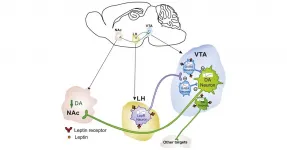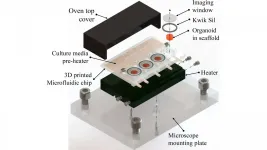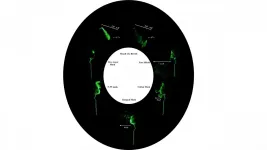(Press-News.org) Philadelphia, April 6, 2021 - Since the discovery of leptin in the 1990s, researchers have wondered, how does leptin, a hormone made by body fat, suppress appetite? Despite tremendous gains in the intervening three decades, many questions still remain. Now, a new study in mice describes novel neurocircuitry between midbrain structures that control feeding behaviors that are under modulatory control by leptin. The study appears in Biological Psychiatry, published by Elsevier.
John Krystal, MD, Editor of Biological Psychiatry, said of the findings, "Omrani and colleagues shed light on how, in non-obese animals, leptin puts the brakes on overeating."
Leptin acts as a critical link between the body and the brain, providing information about metabolic state and exerting control over energy balance. The importance of leptin is illustrated by the finding that animals deficient for leptin rapidly become obese without its regulatory stop on feeding behavior.
Roger Adan, PhD, of the Department of Translational Neuroscience, University Medical Center Utrecht and University Utrecht, the Netherlands, who led the study, said, "This process is shaped by communication between bodily fat storages (via a hormone called leptin) and the brain's dopamine reward system. This leptin-dopamine axis is critically important for body weight control, but its modes of action were not well understood."
Leptin suppresses eating by signaling to brain regions that control eating behaviors, but it also decreases the reward value inherent in foods, engaging the brain's dopamine (DA) reward system. That food-reward pathway was known to involve dopaminergic neurons of the ventral tegmental area (VTA) signaling to the nucleus accumbens (NAc), but most of those DA neurons do not contain receptors for leptin.
The work used a combination of powerful technologies, including optogenetics, chemogenetics and electrophysiology to map the new microcircuitry.
"Although leptin receptors are present on [some] dopamine neurons that signal food reward," said Professor Adan, also of the Department of Translational Neuroscience, University Medical Center Utrecht and University Utrecht, "we discovered that leptin receptors are also present on inhibitory neurons that more strongly regulate the activity of dopamine neurons. Some of these inhibitory neurons suppressed food seeking when [animals were] hungry, whereas others [did so] only when [animals were] in a sated state."
Dr. Krystal said of the study, "It turns out that leptin plays key modulatory roles in an elegant circuit that unites midbrain and limbic reward circuitry. By inhibiting hypothalamic neurons and ultimately suppressing the activity of dopamine neurons in the midbrain that signal reward and promote feeding, leptin reduces food intake in animals under conditions when caloric intake has exceeded energy use."
Ultimately, Professor Adan said, "Targeting these neurons may provide a new avenue for the treatment of anorexia nervosa and to support dieting in people with obesity."
INFORMATION:
Notes for editors
The article is "Identification of novel neurocircuitry through which leptin targets multiple inputs to the dopamine system to reduce food reward seeking,"by Azar Omrani, Veronne de Vrind, Bart Lodder, Iris Stoltenborg, Karlijn Kooij, Inge Wolterink-Donselaar, Mieneke Luijendijk-Berg, Keith Garner, Lisanne van 't Sant, Annemieke Rozeboom, Suzanne Dickson, Frank Meye, Roger Adan (https://doi.org/10.1016/j.biopsych.2021.02.017). It appears as an Article in Press in Biological Psychiatry, published by Elsevier.
Copies of this paper are available to credentialed journalists upon request; please contact Rhiannon Bugno at Biol.Psych@sobp.org or +1 254 522 9700. Journalists wishing to interview the authors may contact Roger Adan at r.a.h.adan@umcutrecht.nl or +31 88 756 8517.
The authors' affiliations and disclosures of financial and conflicts of interests are available in the article.
John H. Krystal, MD, is Chairman of the Department of Psychiatry at the Yale University School of Medicine, Chief of Psychiatry at Yale-New Haven Hospital, and a research psychiatrist at the VA Connecticut Healthcare System. His disclosures of financial and conflicts of interests are available here.
About Biological Psychiatry
Biological Psychiatry is the official journal of the Society of Biological Psychiatry, whose purpose is to promote excellence in scientific research and education in fields that investigate the nature, causes, mechanisms and treatments of disorders of thought, emotion, or behavior. In accord with this mission, this peer-reviewed, rapid-publication, international journal publishes both basic and clinical contributions from all disciplines and research areas relevant to the pathophysiology and treatment of major psychiatric disorders.
The journal publishes novel results of original research which represent an important new lead or significant impact on the field, particularly those addressing genetic and environmental risk factors, neural circuitry and neurochemistry, and important new therapeutic approaches. Reviews and commentaries that focus on topics of current research and interest are also encouraged.
Biological Psychiatry is one of the most selective and highly cited journals in the field of psychiatric neuroscience. It is ranked 7th out of 155 Psychiatry titles and 12th out of 271 Neurosciences titles in the Journal Citations Reports® published by Clarivate Analytics. The 2019 Impact Factor score for Biological Psychiatry is 12.095. http://www.sobp.org/journal
About Elsevier
As a global leader in information and analytics, Elsevier helps researchers and healthcare professionals advance science and improve health outcomes for the benefit of society. We do this by facilitating insights and critical decision-making for customers across the global research and health ecosystems.
In everything we publish, we uphold the highest standards of quality and integrity. We bring that same rigor to our information analytics solutions for researchers, health professionals, institutions and funders.
Elsevier employs 8,100 people worldwide. We have supported the work of our research and health partners for more than 140 years. Growing from our roots in publishing, we offer knowledge and valuable analytics that help our users make breakthroughs and drive societal progress. Digital solutions such as ScienceDirect, Scopus, SciVal, ClinicalKey and Sherpath support strategic research management, R&D performance, clinical decision support, and health education. Researchers and healthcare professionals rely on our 2,500+ digitized journals, including The Lancet and Cell, our 40,000 eBook titles; and our iconic reference works, such as Gray's Anatomy. With the Elsevier Foundation and our external Inclusion & Diversity Advisory Board, we work in partnership with diverse stakeholders to advance inclusion and diversity in science, research and healthcare in developing countries and around the world.
Elsevier is part of RELX, a global provider of information-based analytics and decision tools for professional and business customers. http://www.elsevier.com
Media contact
Rhiannon Bugno, Editorial Office
Biological Psychiatry
+1 254 522 9700
Biol.Psych@sobp.org
In addition to smoothing out wrinkles, researchers have found that the drug Botox can reveal the inner workings of the brain. A new study used it to show that feedback from individual nerve cells controls the release of dopamine, a chemical messenger involved in motivation, memory, and movement.
Such "self-regulation," the researchers say, stands in contrast to the widely held view that the release of dopamine -- known as the "feel good" hormone -- by any cell relied on messages from nearby cells to recognize that it is releasing too much of the hormone.
Led by researchers at NYU Grossman School of Medicine, ...
WASHINGTON, April 6, 2021 -- Scientists from MIT and the Indian Institute of Technology Madras have grown small amounts of self-organizing brain tissue, known as organoids, in a tiny 3D-printed system that allows observation while they grow and develop. The work is reported in Biomicrofluidics, by AIP Publishing.
Current technology for real-time observation of growing organoids involves the use of commercial culture dishes with many wells in a glass-bottomed plate placed under a microscope. The plates are costly and only compatible with specific microscopes. They do not allow for the flow or replenishment of a nutrient medium to the growing tissue.
Recent advances have used a technique known as microfluidics, where a nutrient ...
WASHINGTON, April 6, 2021 -- Cryocoolers are ultracold refrigeration units used in surgery and drug development, semiconductor fabrication, and spacecraft. They can be tubes, pumps, tabletop sizes, or larger refrigerator systems.
The regenerative heat exchanger, or regenerator, is a core component of cryocoolers. At temperatures below 10 kelvins (-441.67 degrees Fahrenheit), performance drops precipitously, with maximum regenerator loss of more than 50%.
In their paper, published in Applied Physics Letters, by AIP Publishing, researchers at the University of Chinese Academy of Sciences used ...
WASHINGTON, April 6, 2021 -- Dragonfly wings, lotus leaves, cicada wings -- thanks to millennia of evolution, nature has optimized the ways these surfaces and others behave to offer antibacterial functionality.
An international, interdisciplinary team of researchers is trying to find the best way to translate these features to create nature-inspired bactericidal surfaces for use in medical implants. They discuss the surface structures and chemical compositions for an ideal implant material in the journal Applied Physics Reviews, from AIP Publishing.
"Objects in ...
What The Study Did: Researchers compared the effectiveness of case-based (including contact tracing and quarantine) and population-based (including social distancing and facial masking) interventions for COVID-19 containment in Taiwan, one of the few countries with initial success in COVID-19 control without strict lockdown or school closure.
Authors: Hsien-Ho Lin, M.D., Sc.D., of National Taiwan University in Taipei, Taiwan, is the corresponding author.
To access the embargoed study: Visit our For The Media website at this link https://media.jamanetwork.com/
(doi:10.1001/jamainternmed.2021.1644)
Editor's Note: The article includes conflicts of interest and funding/support disclosures. Please see the article for additional information, including ...
What The Study Did: This study investigated the role of droplet or contact transmission in the development of Kawasaki disease in Japan during the COVID-19 state of emergency. Kawasaki disease primarily affects children and is characterized by fever and swelling in the walls of some blood vessels.
Authors: Toshiro Hara, M.D., Ph.D., of the Fukuoka Children's Hospital in Fukuoka, Japan, is the corresponding author.
To access the embargoed study: Visit our For The Media website at this link https://media.jamanetwork.com/
(doi:10.1001/jamanetworkopen.2021.4475)
Editor's Note: The article includes conflicts of interest and funding/support disclosures. Please see the article for additional information, ...
What The Study Did: A model to prioritize vaccination was developed that estimates the risk of SARS-CoV-2-related death among enrollees in the Veterans Affairs health care system.
Authors: George N. Ioannou, B.M.B.Ch., M.S., of the Veterans Affairs Puget Sound Healthcare System in Seattle, is the corresponding author.
To access the embargoed study: Visit our For The Media website at this link https://media.jamanetwork.com/
(doi:10.1001/jamanetworkopen.2021.4347)
Editor's Note: The article includes conflicts of interest and funding/support disclosures. Please see the article for additional information, including other authors, author contributions and affiliations, conflict of interest and financial disclosures, and funding and support.
INFORMATION:
Media ...
What The Study Did: The clinical and other characteristics of multisystem inflammatory syndrome in children in the United States, a condition that occurs in association with the COVID-19 pandemic, are described in this study.
Authors: Ermias D. Belay, M.D., of the Centers for Disease Control and Prevention in Atlanta, is the corresponding author.
To access the embargoed study: Visit our For The Media website at this link https://media.jamanetwork.com/
(doi:10.1001/jamapediatrics.2021.0630)
Editor's Note: The article includes conflict of interest ...
WASHINGTON, April 6, 2021 -- With research increasingly showing the COVID-19 virus is transmissible via smaller droplets suspended in air, there is a growing concern current public health guidelines of mask wearing and social distancing are insufficient in combating its spread in indoor environments, like prisons, hospitals, and meatpacking plants, where people tend to be in close quarters.
Most research has focused on coughing and sneezing. But studies on how simply breathing might contribute to airborne spread of the virus are rare.
In AIP Advances, by AIP Publishing, researchers at the Indian Institute of Technology Bhubaneswar show social distancing is equally ...
Spain is among the five countries in the world with the highest levels of social acceptance of LGBTIQ+ people and rights, and was the third country in the world to legalize same-sex marriages, in 2005. In 2019, 3.1% of marriages were between same-sex couples (INE 2020). In this context, it would seem consistent that sexual orientation should not determine wage inequalities. But is this really so? What is the relationship between sexual orientation and wages?
The study, recently published in Journal of Family Issues, found a significant correlation ...



